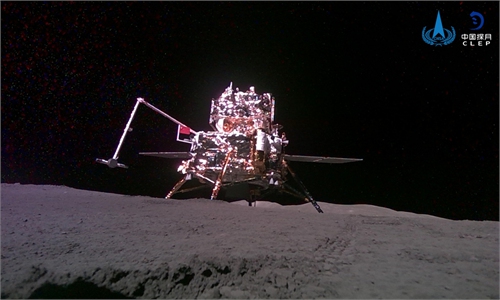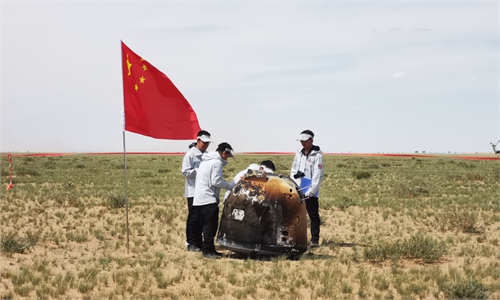Chinese eagerly discuss ‘planting veggies’ on lunar surface following ground-breaking discovery
Finding 'changes human understanding of the moon, facilitates manned lunar missions'
ULM-1, an unidentified mineral crystal. Photo: CCTV news
Following a significant finding by Chinese researchers that for the first time in human history hydrated mineral containing molecular water was found in lunar soil, Chinese netizens started heated discussions over the possibility of growing a variety of vegetables, fruits and flowers on the moon, with the hope of turning Earth's neighbor into another "home garden."
Experts said the newly discovered mineral provides great potential for planting seeds on the moon, but the finding seems only a "step one" for this ambitious dream. They also noted that this discovery not only makes a revolutionary contribution to understanding the evolution of the moon but could also greatly facilitate future manned lunar missions and the establishment of lunar research stations.
On Tuesday, researchers from the Institute of Physics of the Chinese Academy of Sciences (CAS), along with scholars from renowned Chinese universities, revealed they have discovered ULM-1, an unidentified mineral crystal from the lunar samples retrieved by Chang'e-5 mission, which is enriched with water molecules and ammonium, China Central Television (CCTV) reported.
This mineral has water molecules accounting for as much as 41 percent of the sample's mass, according to the report.
"A mineral that contains water molecules has never been found in previously returned lunar soil samples," Jin Shifeng, associate researcher at the Institute of Physics of CAS, said.
Prior research on samples collected by the US Apollo missions from 1969 to 1972 indicated no presence of hydrated minerals in lunar soil. The assumption that the moon lacked water then became a fundamental premise in lunar scientific research, which had a significant impact on understanding lunar volcanic evolution, lunar origin and other related issues.
Chen Xiaolong, another research fellow at the institute, said this result "changed our understanding of whether lunar soil contains water and the form in which water exists."
Chen was quoted in another CCTV report on Thursday as saying that through thermodynamic analysis calculations, we can estimate how much water and water vapor were present during lunar volcanic eruptions in the past, greatly deepening our understanding of the celestial body.
As soon as the good news broke out, Chinese netizens were thrilled to begin brainstorming for ways to explore the mysterious land. Those from the southern parts of China, known for their "hot and spicy" dishes, called for planting "space-borne chili peppers," while others from the north asked if potatoes and green beans can be considered for the moon.
Responding to the eager calls and enthusiasm from the public, Chinese researchers explained that these hydrated minerals are rich in ammonia, which is a type of nitrogen fertilizer, similar to ammonium bicarbonate used on Earth. In addition, there is also small amount of potassium found in the mineral, which is a potassium fertilizer.
Therefore, this discovery provides great potential for humans to grow crops on the moon in the future, they said.
However, Zhang Chuanjun, a senior aerospace breeding engineer, told the Global Times that there remain many issues to consider. "For instance, on Earth, in order to grow any plant, various conditions are required, with water being just one aspect. Other factors include fertilizers, light, temperature, humidity and air. Only when these conditions are met, can plants thrive," he said.
"On the moon, the water we found is not in liquid form but exists in a crystalline form. Therefore, it cannot be directly used for planting, so the next step would be research. We would research how to extract water from the crystals," Zhang noted. Additionally, due to the moon's gravity being only one sixth of Earth's, even if there is water and fertilizer, the ability to retain them and allow plants to absorb them is also a challenge.
In terms of human exploration of the moon, if in the future our taikonauts can extract water vapor or water from these crystals, it would solve a major issue in future manned lunar missions and the construction of lunar research stations, as we would no longer need to transport water from Earth. This would address a significant concern in manned lunar exploration, meanwhile saving substantial costs, Zhang said.
The discovery of hydrated mineral also revealed a possible form of water molecules on the moon - hydrated salt. Unlike volatile water ice, this hydrated material is highly stable in the high latitude regions of the moon. This implies that even in the vast sunlight-exposed areas of the moon, this stable hydrated salt may still exist.
This provides new possibilities for the future development and utilization of lunar resources.
In order to ensure the accuracy of the discovery, Chinese researchers have conducted chemical and chlorine isotope analyses. They found that the composition of the mineral significantly differed from Earth minerals but matched those found on the moon, ruling out Earth contamination or rocket exhaust as the source of this mineral, according to media reports.


